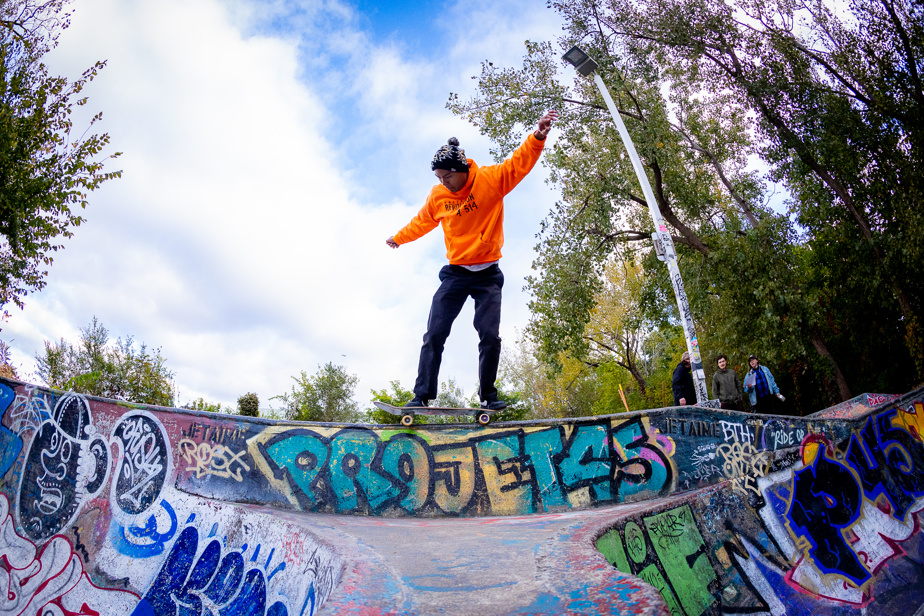Skateboarders want to save one of the last skateparks authentic Montreal locations, along Papineau Avenue. A true community landmark, Project 45 – built by its members – is today threatened with destruction by the City of Montreal, which wants to redevelop it entirely.
“There is no other skate park in Montreal which has as much soul as this one. They are all the same or almost the same, the others. It’s a completely unique place and it must be preserved,” says Charles Bérubé, who has been practicing his sport there for almost four years.
Built based on DIY principles (Do It Yourself), Project 45 has existed for more than ten years. It is located near the TAZ, one of the largest skateparks interiors of the country, at the entrance to Frédéric-Back park. All the structures found there were built and funded voluntarily by its members, making it the largest of its kind in Canada.

PHOTO MARCO CAMPANOZZI, THE PRESS
THEkatepark Project 45
However, it is Montreal which remains the owner of the premises. And the Plante administration is planning “the redevelopment of outdoor spaces around the TAZ”, of which Project 45 is a part.
Five million to do better
Because it says “recognize the need to maintain type equipment skate park at this location”, the City now wishes to build a brand new skate park wanting to be more secure and inclusive. However, this would require “razing everything that is there,” laments snowboarder Marie-Pier Hamelin.

PHOTO DOMINICK GRAVEL, THE PRESS
Windsurfers Marie-Pier Hamelin (foreground) and Frédérik Khun (background)
There are around 5 million on the table for their redevelopment project. It would be enough to redevelop so many things while retaining the DIY appeal, for which people come here from all over the world. It’s a global subculture that we’re fighting for.
Marie-Pier Hamelin, snowboarder
In Portland, she recalls, “they rebuilt the bridge over the skate park historic to preserve it, because they know that it is a place of worship on the international scene. We can do the same in Montreal. It would be a wonderful legacy for future generations and for the city.”
A petition supporting the skateboarders’ efforts had already collected more than 4,400 signatures online at the time of writing.
Frédérique Luyet, who has been involved in the project for 15 years, second.

PHOTO DOMINICK GRAVEL, THE PRESS
The snowboarder Frédérique Luyet
In 2019, I went to represent Canada for the World Cup in Brazil. [Équipe] Canada also took me to Qatar for the Beach Games. And I wouldn’t have been able to do all that if I hadn’t had Project 45. It depresses me that we want to make it something very generic.
Frédérique Luyet, snowboarder
The redevelopment of the park “would also mean that there would be a lot of deforestation,” denounces Frederik Khun.
“We are talking about a hundred mature trees and they want to cut them down to see the street. But cars drive really fast on Papineau. With a skate park bigger, that will mean more children, and without trees, that will mean more risks, more accidents,” he thunders.
Not up to standard, says the City
However, the City of Montreal offers a completely different interpretation of things. “The current equipment of the skate park present end-of-life characteristics – cracks and spalling in the concrete, exposed foundation – which are currently the subject of repeated corrections every spring,” says a spokesperson, Kim Nantais, by email.
She maintains that the places simply do not meet “the standards in terms of development and safety of municipal equipment”, and that they must “consequently be reviewed”.
“Aware of the demands of citizens”, the City says it has enlisted the services of the Association Skateboard Montréal (ASM), with the mandate “to consult citizens on the needs for this space in order to achieve the best redevelopment” .
“The wish to retain certain parts will be evaluated following their requests, but these must respect the standards in force. Meetings have taken place and others are to come depending on the different stages of progress of the project,” adds M.me Nantes.
For the skateboarding community, however, this opening of the City is not really one. “There would be a way to work with them to resolve some of the problems we have, but we have been trying to discuss with them for two years. And they always come back with the complete reconstruction of the park. I think they don’t really want to listen to us,” insists Jason Cadoret Côté.
“It’s a historical heritage that we want to protect,” concludes his friend, Jonathan Charron, also a snowboarder. We don’t want to keep everything, we are aware that there are obsolete things, which are poorly constructed, but we certainly shouldn’t let that disappear. It’s so important, everything we’ve done here. »
